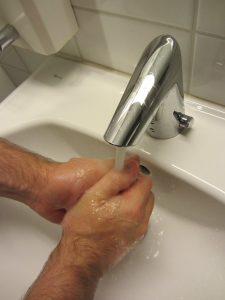




The migration of microbes via touch surfaces can also be reduced by reducing the amount of touch surfaces. Various solutions based on automation already exist, e.g. for lighting and the operation of doors. The automation mechanisms used are often based on movement detection or the detection of the luminous intensity of lights.

Touch-free solutions are particularly suitable for use in public spaces and in spaces with high hygiene requirements. For example, touch-free faucets are suitable in spaces where the hands easily, frequently, and repeatedly get dirty. In many public spaces, touch-free faucets, and touch-free flushing of toilet seats, are already in use. However, the air-based hand-dryers used in public toilets, even if they are touch-free, increase the quantity of microbes in the indoor air. The functionality of a touch-free solution, from the standpoint of promoting hygiene, must be verified prior to the solution’s implementation in an indoor space.
To ensure the functionality of solutions based on automation, it is important to plan and implement the necessary servicing and maintenance, and to ensure that this servicing and maintenance are sufficient.
Mäkinen, R. et al. Manual faucets induce more biofilms than electronic faucets. Canadian Journal of Microbiology 2013; 59(6):407-12. DOI: 10.1139/cjm-2013-0131